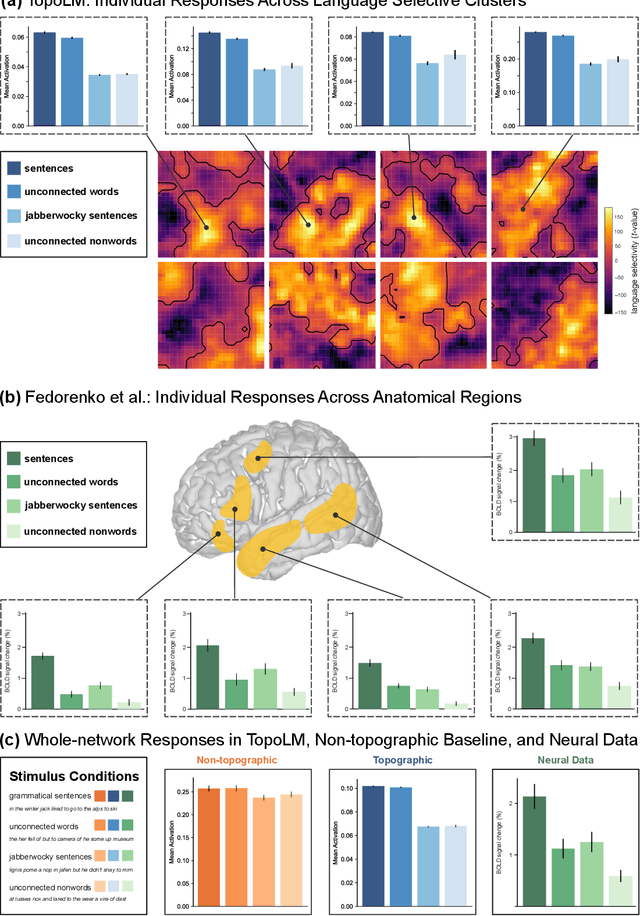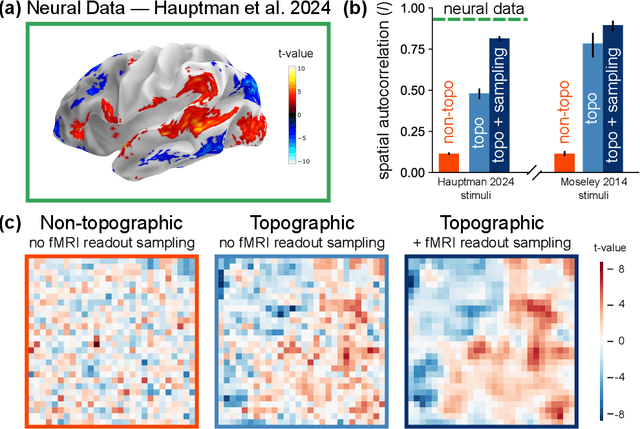Taha Binhuraib
From Language to Cognition: How LLMs Outgrow the Human Language Network
Mar 03, 2025Abstract:Large language models (LLMs) exhibit remarkable similarity to neural activity in the human language network. However, the key properties of language shaping brain-like representations, and their evolution during training as a function of different tasks remain unclear. We here benchmark 34 training checkpoints spanning 300B tokens across 8 different model sizes to analyze how brain alignment relates to linguistic competence. Specifically, we find that brain alignment tracks the development of formal linguistic competence -- i.e., knowledge of linguistic rules -- more closely than functional linguistic competence. While functional competence, which involves world knowledge and reasoning, continues to develop throughout training, its relationship with brain alignment is weaker, suggesting that the human language network primarily encodes formal linguistic structure rather than broader cognitive functions. We further show that model size is not a reliable predictor of brain alignment when controlling for feature size and find that the correlation between next-word prediction, behavioral alignment and brain alignment fades once models surpass human language proficiency. Finally, using the largest set of rigorous neural language benchmarks to date, we show that language brain alignment benchmarks remain unsaturated, highlighting opportunities for improving future models. Taken together, our findings suggest that the human language network is best modeled by formal, rather than functional, aspects of language.
TopoLM: brain-like spatio-functional organization in a topographic language model
Oct 15, 2024



Abstract:Neurons in the brain are spatially organized such that neighbors on tissue often exhibit similar response profiles. In the human language system, experimental studies have observed clusters for syntactic and semantic categories, but the mechanisms underlying this functional organization remain unclear. Here, building on work from the vision literature, we develop TopoLM, a transformer language model with an explicit two-dimensional spatial representation of model units. By combining a next-token prediction objective with a spatial smoothness loss, representations in this model assemble into clusters that correspond to semantically interpretable groupings of text and closely match the functional organization in the brain's language system. TopoLM successfully predicts the emergence of the spatio-functional organization of a cortical language system as well as the organization of functional clusters selective for fine-grained linguistic features empirically observed in human cortex. Our results suggest that the functional organization of the human language system is driven by a unified spatial objective, and provide a functionally and spatially aligned model of language processing in the brain.
ProtoDiffusion: Classifier-Free Diffusion Guidance with Prototype Learning
Jul 04, 2023Abstract:Diffusion models are generative models that have shown significant advantages compared to other generative models in terms of higher generation quality and more stable training. However, the computational need for training diffusion models is considerably increased. In this work, we incorporate prototype learning into diffusion models to achieve high generation quality faster than the original diffusion model. Instead of randomly initialized class embeddings, we use separately learned class prototypes as the conditioning information to guide the diffusion process. We observe that our method, called ProtoDiffusion, achieves better performance in the early stages of training compared to the baseline method, signifying that using the learned prototypes shortens the training time. We demonstrate the performance of ProtoDiffusion using various datasets and experimental settings, achieving the best performance in shorter times across all settings.
 Add to Chrome
Add to Chrome Add to Firefox
Add to Firefox Add to Edge
Add to Edge